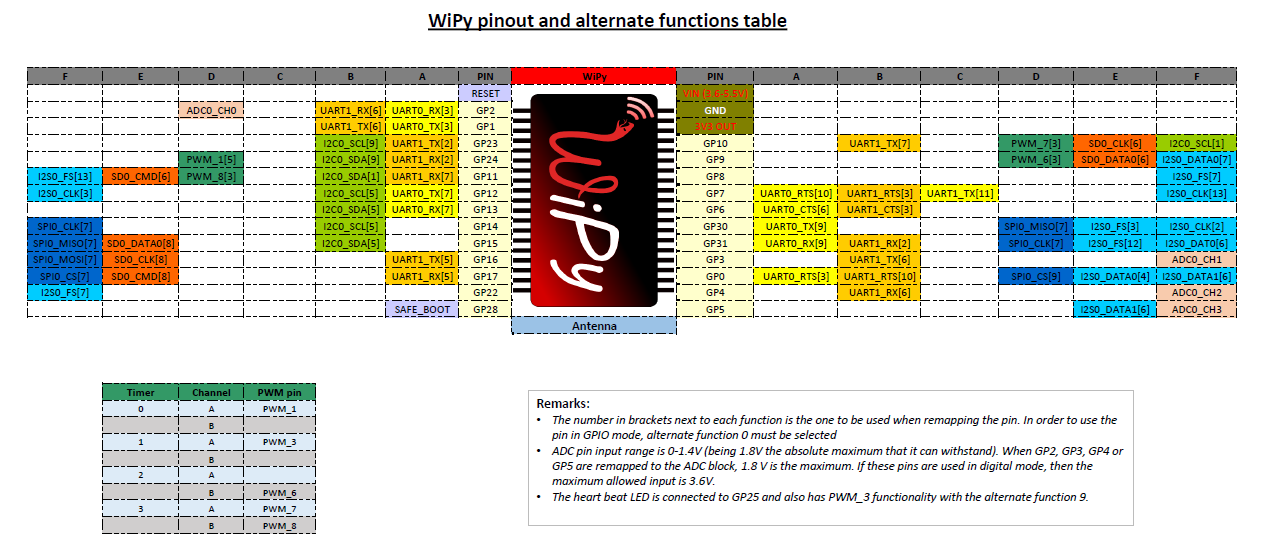Quick reference for the WiPy¶

Below is a quick reference for CC3200/WiPy. If it is your first time working with this board please consider reading the following sections first:
General board control (including sleep modes)¶
See the machine module:
import machine
help(machine) # display all members from the machine module
machine.freq() # get the CPU frequency
machine.unique_id() # return the 6-byte unique id of the board (the WiPy's MAC address)
machine.idle() # average current decreases to (~12mA), any interrupts wake it up
machine.lightsleep() # everything except for WLAN is powered down (~950uA avg. current)
# wakes from Pin, RTC or WLAN
machine.deepsleep() # deepest sleep mode, MCU starts from reset. Wakes from Pin and RTC.
Pins and GPIO¶
See machine.Pin.
from machine import Pin
# initialize GP2 in gpio mode (alt=0) and make it an output
p_out = Pin('GP2', mode=Pin.OUT)
p_out.value(1)
p_out.value(0)
p_out.toggle()
p_out(True)
# make GP1 an input with the pull-up enabled
p_in = Pin('GP1', mode=Pin.IN, pull=Pin.PULL_UP)
p_in() # get value, 0 or 1
Timers¶
See machine.TimerWiPy and machine.Pin.
Timer id’s take values from 0 to 3.:
from machine import Timer
from machine import Pin
tim = Timer(0, mode=Timer.PERIODIC)
tim_a = tim.channel(Timer.A, freq=1000)
tim_a.freq(5) # 5 Hz
p_out = Pin('GP2', mode=Pin.OUT)
tim_a.irq(trigger=Timer.TIMEOUT, handler=lambda t: p_out.toggle())
PWM (pulse width modulation)¶
See machine.Pin and machine.Timer.
from machine import Timer
# timer 1 in PWM mode and width must be 16 buts
tim = Timer(1, mode=Timer.PWM, width=16)
# enable channel A @1KHz with a 50.55% duty cycle
tim_a = tim.channel(Timer.A, freq=1000, duty_cycle=5055)
ADC (analog to digital conversion)¶
See machine.ADCWiPy.
from machine import ADC
adc = ADC()
apin = adc.channel(pin='GP3')
apin() # read value, 0-4095
UART (serial bus)¶
See machine.UART.
from machine import UART
uart = UART(0, baudrate=9600)
uart.write('hello')
uart.read(5) # read up to 5 bytes
SPI bus¶
See machine.SPI.
from machine import SPI
# configure the SPI master @ 2MHz
spi = SPI(0, SPI.MASTER, baudrate=200000, polarity=0, phase=0)
spi.write('hello')
spi.read(5) # receive 5 bytes on the bus
rbuf = bytearray(5)
spi.write_readinto('hello', rbuf) # send and receive 5 bytes
I2C bus¶
See machine.I2C.
from machine import I2C
# configure the I2C bus
i2c = I2C(baudrate=100000)
i2c.scan() # returns list of slave addresses
i2c.writeto(0x42, 'hello') # send 5 bytes to slave with address 0x42
i2c.readfrom(0x42, 5) # receive 5 bytes from slave
i2c.readfrom_mem(0x42, 0x10, 2) # read 2 bytes from slave 0x42, slave memory 0x10
i2c.writeto_mem(0x42, 0x10, 'xy') # write 2 bytes to slave 0x42, slave memory 0x10
Watchdog timer (WDT)¶
See machine.WDT.
from machine import WDT
# enable the WDT with a timeout of 5s (1s is the minimum)
wdt = WDT(timeout=5000)
wdt.feed()
Real time clock (RTC)¶
See machine.RTC
from machine import RTC
rtc = RTC() # init with default time and date
rtc = RTC(datetime=(2015, 8, 29, 9, 0, 0, 0, None)) # init with a specific time and date
print(rtc.now())
def alarm_handler (rtc_o):
pass
# do some non blocking operations
# warning printing on an irq via telnet is not
# possible, only via UART
# create a RTC alarm that expires after 5 seconds
rtc.alarm(time=5000, repeat=False)
# enable RTC interrupts
rtc_i = rtc.irq(trigger=RTC.ALARM0, handler=alarm_handler, wake=machine.SLEEP)
# go into suspended mode waiting for the RTC alarm to expire and wake us up
machine.lightsleep()
SD card¶
See machine.SD.
from machine import SD
import os
# clock pin, cmd pin, data0 pin
sd = SD(pins=('GP10', 'GP11', 'GP15'))
# or use default ones for the expansion board
sd = SD()
os.mount(sd, '/sd')
WLAN (WiFi)¶
See network.WLAN and machine.
import machine
from network import WLAN
# configure the WLAN subsystem in station mode (the default is AP)
wlan = WLAN(mode=WLAN.STA)
# go for fixed IP settings
wlan.ifconfig(config=('192.168.0.107', '255.255.255.0', '192.168.0.1', '8.8.8.8'))
wlan.scan() # scan for available networks
wlan.connect(ssid='mynetwork', auth=(WLAN.WPA2, 'mynetworkkey'))
while not wlan.isconnected():
pass
print(wlan.ifconfig())
# enable wake on WLAN
wlan.irq(trigger=WLAN.ANY_EVENT, wake=machine.SLEEP)
# go to sleep
machine.lightsleep()
# now, connect to the FTP or the Telnet server and the WiPy will wake-up
Telnet and FTP server¶
See network.Server
from network import Server
# init with new user, password and seconds timeout
server = Server(login=('user', 'password'), timeout=60)
server.timeout(300) # change the timeout
server.timeout() # get the timeout
server.isrunning() # check whether the server is running or not